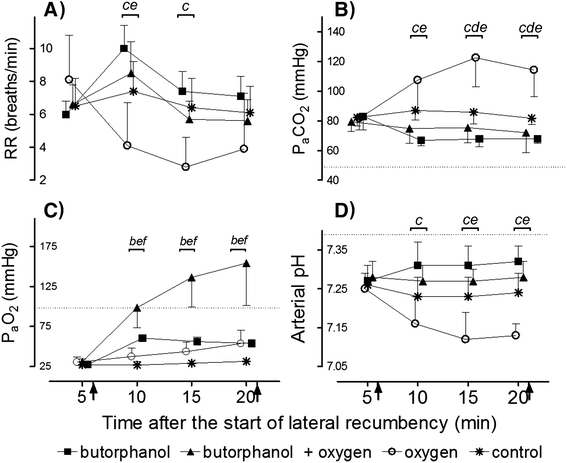Butorphanol with oxygen insufflation corrects etorphine-induced hypoxaemia in chemically immobilized white rhinoceros (Ceratotherium simum)
- PMID: 25315767
- PMCID: PMC4205281
- DOI: 10.1186/s12917-014-0253-0
Butorphanol with oxygen insufflation corrects etorphine-induced hypoxaemia in chemically immobilized white rhinoceros (Ceratotherium simum)
Abstract
Background: Opioid-induced immobilization is associated with severe respiratory depression in the white rhinoceros. We evaluated the efficacy of butorphanol and oxygen insufflation in alleviating opioid-induced respiratory depression in eight boma-managed rhinoceros.
Results: Chemical immobilization with etorphine, azaperone and hyaluronidase, as per standard procedure for the white rhinoceros, caused severe respiratory depression with hypoxaemia (PaO2 = 27 ± 7 mmHg [mean ± SD]), hypercapnia (PaCO2 = 82 ± 6 mmHg) and acidosis (pH =7.26 ± 0.02) in the control trial at 5 min. Compared to pre-intervention values, butorphanol administration (without oxygen) improved the PaO2 (60 ± 3 mmHg, F (3,21) =151.9, p < 0.001), PaCO2 (67 ± 4 mmHg, F (3,21) =22.57, p < 0.001) and pH (7.31 ± 0.06, F (3,21) = 27.60, p < 0.001), while oxygen insufflation alone exacerbated the hypercapnia (123 ± 20 mmHg, F (3,21) = 50.13, p < 0.001) and acidosis (7.12 ± 0.07, F (3,21) = 110.6, p < 0.001). Surprisingly, butorphanol combined with oxygen fully corrected the opioid-induced hypoxaemia (PaO2 = 155 ± 53 mmHg) and reduced the hypercapnia over the whole immobilization period (p <0.05, areas under the curves) compared to the control trial. However, this intervention (butorphanol + oxygen) did not have any effect on the arterial pH.
Conclusions: Oxygen insufflation combined with a single intravenous dose of butorphanol improved the immobilization quality of boma-managed white rhinoceros by correcting the opioid-induced hypoxaemia, but did not completely reverse all components of respiratory depression. The efficacy of this intervention in reducing respiratory depression in field-captured animals remains to be determined.
Figures


Similar articles
-
Butorphanol with oxygen insufflation improves cardiorespiratory function in field-immobilised white rhinoceros (Ceratotherium simum).J S Afr Vet Assoc. 2015 Aug 12;86(1):E1-E10. doi: 10.4102/jsava.v86i1.1276. J S Afr Vet Assoc. 2015. PMID: 26304140 Free PMC article.
-
Use of butorphanol and diprenorphine to counter respiratory impairment in the immobilised white rhinoceros (Ceratotherium simum).J S Afr Vet Assoc. 2018 Oct 18;89(0):e1-e8. doi: 10.4102/jsava.v89i0.1683. J S Afr Vet Assoc. 2018. PMID: 30456980 Free PMC article.
-
Effects of Butorphanol on Respiration in White Rhinoceros (Ceratotherium simum) Immobilized with Etorphine-Azaperone.J Wildl Dis. 2024 Apr 1;60(2):388-400. doi: 10.7589/JWD-D-23-00034. J Wildl Dis. 2024. PMID: 38268196
-
Intravenous butorphanol improves cardiopulmonary parameters in game-ranched white rhinoceroses (Ceratotherium simum) immobilized with etorphine and azaperone.J Wildl Dis. 2014 Oct;50(4):849-57. doi: 10.7589/2013-12-327. Epub 2014 Aug 8. J Wildl Dis. 2014. PMID: 25105814 Clinical Trial.
-
A review of drugs and techniques used for sedation and anaesthesia in captive rhinoceros species.Aust Vet J. 2004 Sep;82(9):542-9. doi: 10.1111/j.1751-0813.2004.tb11196.x. Aust Vet J. 2004. PMID: 15478725 Review.
Cited by
-
Arterial Blood Gases and Cardiorespiratory Parameters in Etorphine-Medetomidine-Midazolam Immobilized Free-Ranging and Game-Farmed Southern White Rhinoceroses (Ceratotherium simum simum) Undergoing Electro-Ejaculation.Front Vet Sci. 2022 Apr 27;9:862100. doi: 10.3389/fvets.2022.862100. eCollection 2022. Front Vet Sci. 2022. PMID: 35573418 Free PMC article.
-
A Comparison of Hematological, Immunological, and Stress Responses to Capture and Transport in Wild White Rhinoceros Bulls (Ceratotherium simum simum) Supplemented With Azaperone or Midazolam.Front Vet Sci. 2020 Oct 20;7:569576. doi: 10.3389/fvets.2020.569576. eCollection 2020. Front Vet Sci. 2020. PMID: 33195552 Free PMC article.
-
Reliability, clinical performance and trending ability of a pulse oximeter and pulse co-oximeter, in monitoring blood oxygenation, at two measurement sites, in immobilised white rhinoceros (Ceratotherium simum).BMC Vet Res. 2024 Jul 16;20(1):319. doi: 10.1186/s12917-024-04179-5. BMC Vet Res. 2024. PMID: 39014383 Free PMC article.
-
Butorphanol with oxygen insufflation improves cardiorespiratory function in field-immobilised white rhinoceros (Ceratotherium simum).J S Afr Vet Assoc. 2015 Aug 12;86(1):E1-E10. doi: 10.4102/jsava.v86i1.1276. J S Afr Vet Assoc. 2015. PMID: 26304140 Free PMC article.
-
Co-production and conservation physiology: outcomes, challenges and opportunities arising from reflections on diverse co-produced projects.Conserv Physiol. 2025 Jul 18;13(1):coaf049. doi: 10.1093/conphys/coaf049. eCollection 2025. Conserv Physiol. 2025. PMID: 40688760 Free PMC article.
References
-
- Heard DJ, Olsen JH, Stover J. Cardiopulmonary changes associated with chemical immobilization and recumbency in a white rhinoceros (Ceratotherium simum) J Zoo Wildl Med. 1992;23:197–200.
-
- Hatting J, Knox CM. Arterial blood pressure and blood gas composition of white rhinoceroses under etorphine anaesthesia. S Afr J Wildl Res. 1994;24:12–14.
-
- Bush M, Raath JP, Grobler D, Klein L. Severe hypoxaemia in field-anaesthetised white rhinoceros (Ceratotherium simum) and effects of using tracheal insufflation of oxygen. J S Afr Vet Assoc. 2004;72:79–84. - PubMed
Publication types
MeSH terms
Substances
LinkOut - more resources
Full Text Sources
Other Literature Sources

